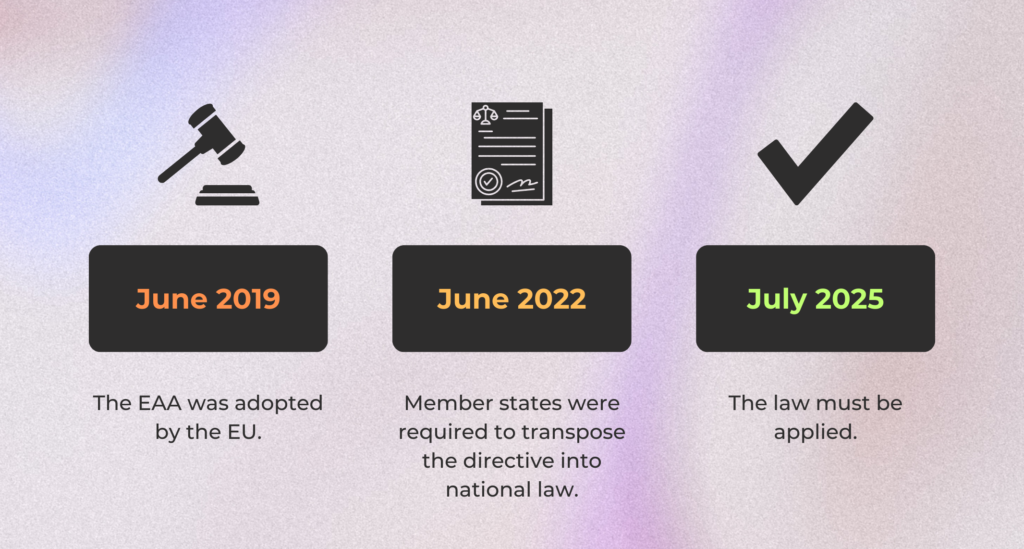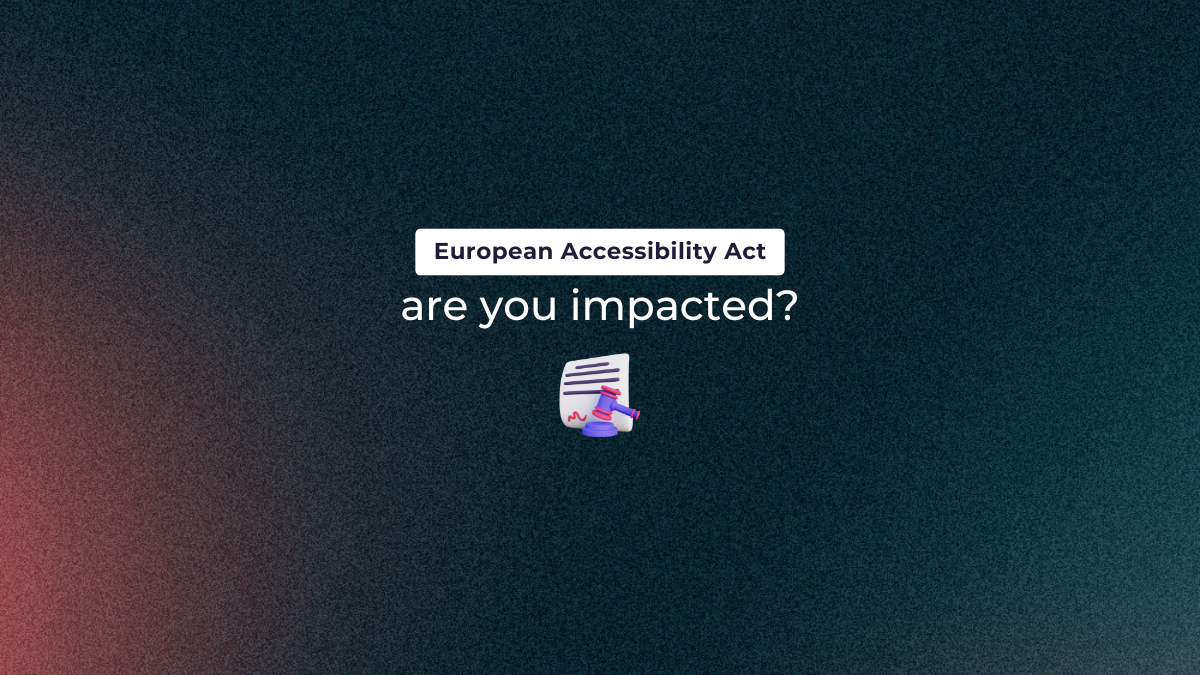On June 28, 2025, the European Accessibility Act will come into effect. This means that both governments and companies must follow the accessibility guidelines.
However, many businesses are unclear about what this law requires, how it applies to them, or why they need to take action now.
Let’s break it down in simple terms so you can be prepared.
Key Points to Remember:
- Effective Date: June 28, 2025
- Who Needs to Comply: All businesses with more than 10 employees and a turnover exceeding €2 million or an annual balance sheet total exceeding €2 million providing products or services within the EU.
- What’s Included: Websites, mobile apps, digital services, and physical spaces must meet accessibility standards.
- Technical Requirements: Products and services must comply with EN 301 549, the European standard for ICT accessibility, which directly adopts WCAG 2.1 AA guidelines to ensure compatibility with assistive technologies.
- Legal Consequences: Businesses that don’t comply may face fines up to €250,000 or, in some cases, legal action.
Table of Contents
First things first - what is the European Accessibility Act?
European Accessibility Act (EAA) is a law that requires businesses and organizations in the European Union to make their products and services accessible to everyone, including people with disabilities. This includes websites, apps, electronic devices, and more.
The goal is to ensure that people with disabilities can easily use and access these services, making society more inclusive for everyone.
Who Needs to Comply?
SERVICES
PRODUCTS
- E-books
- E-commerce
- Digital services
- Consumer banking
- Video streaming and television
- Telephone and online communications
- Services that receive emergency calls to the single European number ‘112’
- Passenger transportation via air, bus, rail, and water
- E-readers
- Computers and operating systems
- Payment terminals
- Certain self-service kiosks such as ATMs, ticketing and check-in machines, and interactive self-service information kiosks
- Smartphones and other equipment for accessing telecommunication services
- TV equipment involving digital television services
What are the exceptions?
Small businesses with fewer than 10 employees and less than €2M annual turnover are exempt from the requirements or businesses for whom compliance would cause an “undue burden” if it would cause serious financial hardship or significantly alter their product or service.
Certain types of digital content qualify as exceptions to the EAA, meaning they are not required to meet the law’s accessibility requirements.
These exceptions include:
- Pre-recorded time-based media published before June 28, 2025
- Office file formats published before June 28, 2025
- Online maps and mapping services, if essential information is provided in an accessible digital manner for maps intended for navigational use
- Third-party content that is neither funded by, developed by, nor under the control of the economic operator concerned
- Content of websites and mobile applications qualifying as archives (only containing content that is not updated or edited after June 28, 2025)
Third-Party Products and Compliance
If your organization integrates third-party technology into your products or services, you are responsible for ensuring its compliance with the EAA. Your procurement policies should include guidelines for assessing the accessibility of third-party products before purchasing or incorporating them.
What Are the Deadlines for Compliance?
EAA was adopted by the EU in June 2019. By June 2022, member states had to incorporate it into their national laws. The final deadline is June 28, 2025, when enforcement begins.
Starting June 2025, businesses that don’t comply may face fines or legal consequences, depending on local enforcement rules.

For certain products (e.g., ATMs, ticketing machines, or self-service terminals already in use before June 28, 2025), a replacement can be delayed until June 28, 2030 if retrofitting is too costly.
Key Requirements of the EAA
The best way for organizations to prove compliance with these functional requirements is to conform with EN 301 549, which incorporates the Web Content Accessibility Guidelines (WCAG) 2.1 Level AA criteria.
EAA is based on four key accessibility principles:
- Perceivable – make content usable for people with different sensory abilities.
- Operable – allow users to navigate and use content easily.
- Understandable – present content and operation in a clear and understandable way.
- Robust – ensure your content is compatible with different user agents, including assistive technologies.
Common national requirements include accessibility training for employees and ongoing monitoring of accessibility standards. Many organizations covered by the EAA must also publish an accessibility statement detailing:
- How a product or service meets the EAA’s requirements
- Accessibility features and technical specifications
- Design processes and compliance documentation
- Names of enforcement authorities where users can file complaints
What are the consequences of non-compliance?
Individual EU countries will monitor the European Accessibility Act, and organizations that don’t comply could face serious consequences. Penalties may vary by country, but could include hefty fines (up to few million euros or even jail time), removal of products or services from the market, or even suspension of a company’s ability to operate.
How to Start Preparing for the EAA
If your business falls under the scope of the EAA, here are some steps to get started:
Step 1: Identify which products or services in your portfolio require EAA compliance.
Step 2: Allocate budget to support your accessibility initiatives.
Step 3: Conduct an audit to identify accessibility gaps in your products and services.
Step 4: Create a roadmap for fixing identified accessibility issues, securing resources and expertise needed, include timelines and responsibilities.
Step 5: Create a roadmap for meeting the requirements, securing resources needed, include timelines and responsibilities. We suggest starting with small, quick fixes to see immediate improvements. These simple changes will help you build momentum and set the stage for addressing more complex accessibility challenges down the road.
Step 6: Implement monitoring to catch any new WCAG violations that may arise from content or feature updates.
Consider partnering with accessibility partners like Kloosive. We use a hybrid approach to accessibility testing, fixing, and monitoring to ensure effective compliance. While our automated tools handle testing, fixes, and ongoing monitoring, our experts refine the remediation for issues that automation alone can’t detect.
The EAA: Driving Innovation and Fostering Inclusivity
The June 2025 deadline is fast approaching. Don’t wait to start your compliance journey – the benefits of accessibility far outweigh the challenges. Whether you’re a business owner, a service provider, or a public agency, embracing accessibility is a win for everyone.
Want to assess your website’s accessibility? Use the Kloosive Accessibility Checker to scan your digital content.
